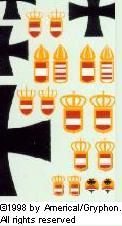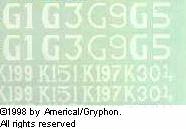Review:
K.ü.K Seeflieger from Americal/Gryphon Decals
Sheet 146 (1/72-scale Albatros, Fokker, Hansa-Brandenburg CC/W.18, and Oeffag types)
Sheet 147 (1/48-scale Albatros, Hansa-Brandenburg CC, and Oeffag types),
Sheet 148 (1/48-scale Fokker, Hansa-Brandenburg W.18, and Oeffag types).
33 aircraft in all. 1998.
 The latest release in Americal/Gryphon's unbelievably comprehensive line of WW1 decals perfectly illustrates the scholarly,
uncommercial approach that this publisher takes towards the business of making hobbyist decals. Of the 33 different
aircraft covered by these sheets, only one, the Fokker E.III fighter monoplane, has ever been represented by a readily
available model kit. The remainder—all flying boats—range from the tiny Hansa-Brandenburg CC and W.18 fighters, through
various single-engined general-purpose types, up to a number of big, multiengined G-class boats. To use the majority of the
decals, the modeler will have to build from scratch.
The latest release in Americal/Gryphon's unbelievably comprehensive line of WW1 decals perfectly illustrates the scholarly,
uncommercial approach that this publisher takes towards the business of making hobbyist decals. Of the 33 different
aircraft covered by these sheets, only one, the Fokker E.III fighter monoplane, has ever been represented by a readily
available model kit. The remainder—all flying boats—range from the tiny Hansa-Brandenburg CC and W.18 fighters, through
various single-engined general-purpose types, up to a number of big, multiengined G-class boats. To use the majority of the
decals, the modeler will have to build from scratch.
 The printing quality on our sample is about average for Americal. Some of the crosses have minor registration problems, none
of which would render the affected decals unusable. The crown and shield markings used on the tails of Austro-Hungarian
naval aircraft are somewhat soft around the edges, but the letter and number codes are as crisp as anyone could ask for.
Some of the wing markings are absolutely huge—3 inches across in 1/48 scale—a clear indication of the size of some of
the G-class aircraft. Large swathes of the red-white-red striping that graced the wings of navy airplanes are included in the sets.
But these are not particularly successful. The color demarcations are fuzzier than they would be if you masked them
off and painted them yourself, and it would be easy to do stripes with red and white trim film. The reds are also
noticeably pinkish. This may be correct—Americal are known for their attention to color—but the effect is just not
convincing, in this writer's view.
The printing quality on our sample is about average for Americal. Some of the crosses have minor registration problems, none
of which would render the affected decals unusable. The crown and shield markings used on the tails of Austro-Hungarian
naval aircraft are somewhat soft around the edges, but the letter and number codes are as crisp as anyone could ask for.
Some of the wing markings are absolutely huge—3 inches across in 1/48 scale—a clear indication of the size of some of
the G-class aircraft. Large swathes of the red-white-red striping that graced the wings of navy airplanes are included in the sets.
But these are not particularly successful. The color demarcations are fuzzier than they would be if you masked them
off and painted them yourself, and it would be easy to do stripes with red and white trim film. The reds are also
noticeably pinkish. This may be correct—Americal are known for their attention to color—but the effect is just not
convincing, in this writer's view.
 On the whole, the decals are well worth the modest price Americal asks. But it is hard to see what market there is
for such things. Modelers with the skills and patience necessary for scratch-building any of the subjects covered should
be more than capable of creating the simple markings of these aircraft by hand. Yet, even they may want to
consider the sheet if only for the superbly rendered codes and serial numbers, none of which look particularly easy to hand paint.
On the whole, the decals are well worth the modest price Americal asks. But it is hard to see what market there is
for such things. Modelers with the skills and patience necessary for scratch-building any of the subjects covered should
be more than capable of creating the simple markings of these aircraft by hand. Yet, even they may want to
consider the sheet if only for the superbly rendered codes and serial numbers, none of which look particularly easy to hand paint.
Conditionally recommended (for specialists and scratch builders).
Text and illustrations © 1998 by Robert Craig Johnson. Images are not to scale.
 The latest release in Americal/Gryphon's unbelievably comprehensive line of WW1 decals perfectly illustrates the scholarly,
uncommercial approach that this publisher takes towards the business of making hobbyist decals. Of the 33 different
aircraft covered by these sheets, only one, the Fokker E.III fighter monoplane, has ever been represented by a readily
available model kit. The remainder—all flying boats—range from the tiny Hansa-Brandenburg CC and W.18 fighters, through
various single-engined general-purpose types, up to a number of big, multiengined G-class boats. To use the majority of the
decals, the modeler will have to build from scratch.
The latest release in Americal/Gryphon's unbelievably comprehensive line of WW1 decals perfectly illustrates the scholarly,
uncommercial approach that this publisher takes towards the business of making hobbyist decals. Of the 33 different
aircraft covered by these sheets, only one, the Fokker E.III fighter monoplane, has ever been represented by a readily
available model kit. The remainder—all flying boats—range from the tiny Hansa-Brandenburg CC and W.18 fighters, through
various single-engined general-purpose types, up to a number of big, multiengined G-class boats. To use the majority of the
decals, the modeler will have to build from scratch. The printing quality on our sample is about average for Americal. Some of the crosses have minor registration problems, none
of which would render the affected decals unusable. The crown and shield markings used on the tails of Austro-Hungarian
naval aircraft are somewhat soft around the edges, but the letter and number codes are as crisp as anyone could ask for.
Some of the wing markings are absolutely huge—3 inches across in 1/48 scale—a clear indication of the size of some of
the G-class aircraft. Large swathes of the red-white-red striping that graced the wings of navy airplanes are included in the sets.
But these are not particularly successful. The color demarcations are fuzzier than they would be if you masked them
off and painted them yourself, and it would be easy to do stripes with red and white trim film. The reds are also
noticeably pinkish. This may be correct—Americal are known for their attention to color—but the effect is just not
convincing, in this writer's view.
The printing quality on our sample is about average for Americal. Some of the crosses have minor registration problems, none
of which would render the affected decals unusable. The crown and shield markings used on the tails of Austro-Hungarian
naval aircraft are somewhat soft around the edges, but the letter and number codes are as crisp as anyone could ask for.
Some of the wing markings are absolutely huge—3 inches across in 1/48 scale—a clear indication of the size of some of
the G-class aircraft. Large swathes of the red-white-red striping that graced the wings of navy airplanes are included in the sets.
But these are not particularly successful. The color demarcations are fuzzier than they would be if you masked them
off and painted them yourself, and it would be easy to do stripes with red and white trim film. The reds are also
noticeably pinkish. This may be correct—Americal are known for their attention to color—but the effect is just not
convincing, in this writer's view. On the whole, the decals are well worth the modest price Americal asks. But it is hard to see what market there is
for such things. Modelers with the skills and patience necessary for scratch-building any of the subjects covered should
be more than capable of creating the simple markings of these aircraft by hand. Yet, even they may want to
consider the sheet if only for the superbly rendered codes and serial numbers, none of which look particularly easy to hand paint.
On the whole, the decals are well worth the modest price Americal asks. But it is hard to see what market there is
for such things. Modelers with the skills and patience necessary for scratch-building any of the subjects covered should
be more than capable of creating the simple markings of these aircraft by hand. Yet, even they may want to
consider the sheet if only for the superbly rendered codes and serial numbers, none of which look particularly easy to hand paint.